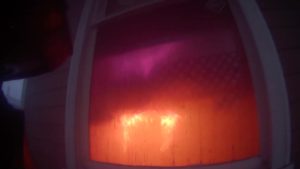There is a lot to learn from these two videos.
First, let’s talk about what is happening. The fire room is the same in both videos, as is the vent profile and the fuel load. The fire room is a bedroom directly off the living room. This means the path is an open room into another open room. (This is an important consideration when talking about the attack but more on that later.)
Point 1: We talk all the time about how to make an attack on a vented fire. What about when we find the fire, but the door is closed. How do we set up? How do we predict what is going to happen when the door is opened? Will there be rapid-fire growth or not? Will the fire come towards us or stay where it is? In this video we find the door closed but beginning to burn through at the top with pressurized smoke pushing out around the door frame down to floor level. This level of pressure behind the door tells us that the smoke, and the room, are very hot. (See Charles Law for more on this.) Given this, we should not be surprised that the smoke auto ignites after the door is opened. (In the real-world water application should have begun as soon as the door was opened preventing ignition. The smoke was allowed to ignite to demonstrate the effect to the students.)
Point 2: When most people drill pushing fires, they do so in hallway props. This makes it easy for the student to visualize where to put the stream because the pathway is naturally defined. The students at this acquired structure had made multiple pushes with live fire in Conex box hallways. The problem is that this does not prepare you to make a push in the scenario shown in these videos.
In this video (Wide Stream) visibility goes to zero once the line opens up, but fire can still be seen pushing forward despite the fact that water can be heard flowing. What has happened is that the student is making huge circles with the stream attempting to find the “walls of the hallway.” With the stream flowing wide, no water is actually entering the fire room. The heat and smoke coming out of the door vaporize the water bouncing off the ceiling and walls and the resulting steam dumps the visibility and increases the local heat. Once the instructor prompts the student to correct the problem the student tights the flow, water can be heard entering the room and the fire goes out.
In this video, (Good Seal) the student has the advantage of having watched the fire before. As soon as the rollover ahead of them is controlled they tighten up the pattern and seal the door to the fire room with the stream. This preserved visibility and eliminated steam production.
Key things to remember: If you are searching ahead of the line and find a door with pressurized smoke like this, you should expect fire as soon as it is opened. If you are pushing from one open room to another, once you gain control of the room you are in the stream should we used to seal the doorway and put water into the next space. How long you work the stream in the room you are in will depend on the amount of fire/heat in the space. In these examples, there is only a small amount of gas flame in the overhead that is cooled in only a few passes of the stream.



